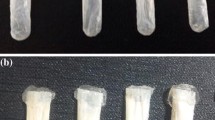Abstract
Drug delivery systems based on different glucose and hydroxypropyl cellulose (HPC) ratios were prepared and characterized to check their suitability as controlled drug delivery carriers. The surface polarity and topography were analyzed and correlated with the glucose/HPC ratio and the drug release mechanism. Different mathematical models were used to fit the “in vitro” release data to understand the glucose release mechanism. The in vitro release data analyzed using various kinetic models showed that all the samples were governed by first-order kinetics; however, one sample seems to have a behavior closer to zero-order kinetics. When a higher percentage HPC was added, the release process was described by Fickian diffusion. An anomalous diffusion was correlated with a lower HPC content. The study showed that glucose/HPC is an interesting matrix for the preparation of controlled release systems which can provide a constant glucose dose over a 4-h period.







Similar content being viewed by others
References
Andreopoulos AG (1995) Controlled release of newer quinolone from biodegradable systems based on poly(lactic acid). J Biomater Appl 10(2):163–169
Nitsch MJ, Banakar UV (1994) Implantable drug delivery. J Biomater Appl 8:247–284
Rogojanu A, Rusu E, Olaru N, Dobromir M, Dorohoi DO (2011) Development and characterization of poly(vinyl alcohol) matrix for drug release. J Nanomater Biosyst 6:809–818
Narasimhan B, Peppas N (1997) Molecular analysis of drug delivery systems controlled by dissolution of the polymer carrier. J Pharm Sci 86:297–304
Costa P, Lobo JMS (2001) Modeling and comparison of dissolution profiles. Eur J Pharm Sci 13:123–133
Andreopoulos AG, Tarantili PA (2002) Study of biopolymers as carriers for controlled release. J Macromol Sci B 41:559–578
Rao KVR, Devi KP (1988) Swelling controlled-release systems: recent developments and applications. Int J Pharm 48:1–13
Coşuţchi AI, Hulubei C, Stoica I, Ioan S (2010) Morphological and structural-rheological relationship in epiclon-based polyimide/hydroxypropylcellulose blend systems. J Polym Res 17:541–550
Coşuţchi AI, Hulubei C, Stoica I, Ioan S (2011) A new approach for patterning epiclon-based polyimide precursor films using a lyotropic liquid crystal template. J Polym Res 18:2389–2402
Dobos AM, Onofrei MD, Stoica I, Olaru N, Olaru L, Ioan S (2012) Rheological properties and microstructures of cellulose acetate phthalate/hydroxypropyl cellulose blends. Polym Compos 33:2072–2083
Şakar-Deliormanli A (2013) Effect of cationic polyelectrolyte on the flow behavior of hydroxypropyl methyl cellulose/polyacrylic acid interpolymer complexes. J Macromol Sci Part B 52:1531–1544
Guan Y, Zhang Y, Zhou T, Zhou S (2009) Stability of hydrogen-bonded hydroxypropylcellulose/poly(acrylic acid) microcapsules in aqueous solutions. Soft Matter 5:842–849
Razzaq HA, Sutton KH, Motoi L (2011) Modifying glucose release from high carbohydrate foods with natural polymers extracted from cereals. J Sci Food Agric 91:2621–2627
Liu G, Ma R, Ren J, Li Z, Zhang H, Zhang Z, Ana Y, Shi L (2013) A glucose-responsive complex polymeric micelle enabling repeated on–off release and insulin protection. Soft Matter 9:1636–1644
Ford JL, Rubinstein MH, Hogan JE (1985) Formulation of sustained release promethazine hydrochloride tablets using hydroxypropylmethyl cellulose matrices. Int J Pharm 24:327–338
Hansen Solubility Parameters (2007) A user’s handbook, 2nd edn. Charles M. Hansen, CRC Press, Boca Raton
Khayet M, Fernández V (2012) Estimation of the solubility parameters of model plant surfaces and agrochemicals: a valuable tool for understanding plant surface interactions. Theor Biol Med Model 9:45–66
Mark JE (1999) Polymer data handbook. Oxford University Press, Oxford
Sievens-Figueroa L, Bhakay A, Jerez-Rozo JI, Pandya N, Romañach RJ, Michniak-Kohn B, Iqbal Z, Bilgili E, Davé RN (2012) Preparation and characterization of hydroxypropyl methyl cellulose films containing stable BCS class II drug nanoparticles for pharmaceutical applications. Int J Pharm 423:496–508
Singh B, Chauhan N (2008) Molecular imprinted polymers for use as drug delivery devices: preliminary evaluation. J Macromol Sci Part A Pure Appl Chem 45:776–784
Ibrahim M, Alaam M, El-Haes H, Jalbout AF, de Leon A (2006) Analysis of the structure and vibrational spectra of glucose and fructose. Ecl Quím São Paulo 31:15–21
van Oss CJ (1994) Interfacial forces in aqueous media. Marcel Dekker Inc, New York
Kaelble DH (1970) Dispersion-polar surface tension properties of organic solids. J Adhes 2:66–81
Rankl M, Laib S, Seeger S (2003) Surface tension properties of surface-coatings for applications in biodiagnostics determined by contact angle Measurements. Coll Surf B 30:177–186
Nechifor CD, Ciobanu CL, Dorohoi DO, Ciobanu C (2009) Polymeric films properties of poly (vinyl alcohol) and poly (hydroxy urethane) in different concentrations. UPB Sci Bull Series A 71:97–106
Thapa P, Stevens HNE, Baillie AJ (2009) In vitro drug release studies from a novel lyophilised nasal dosage form. KUSET 5(1):71–86
Hadjiioannou TP, Christian GD, Koupparis MA, Macheras PE (1993) Quantitative calculations in pharmaceutical practice and research. VCH Publishers Inc., New York
Bourne DWA (2002) Pharmacokinetics. In: Banker GS, Rhodes CT (eds) Modern pharmaceutics, 4th edn. Marcel Dekker Inc., New York, pp 87–142
Higuchi T (1963) Mechanism of sustained action medication. Theoretical analysis of rate of release of solid drugs dispersed in solid matrices. J Pharm Sci 52:1145–1149
Hixson AW, Crowell JH (1931) Dependence of reaction velocity upon surface and agitation (I) theoretical consideration. Ind Eng Chem 23:923–931
Korsmeyer RW, Gurny R, Doelker E, Buri P, Peppas NA (1983) Mechanisms of solute release from porous hydrophilic polymers. Int J Pharm 15:25–35
Liechty WB, Kryscio DR, Slaughter BV, Peppas NA (2010) Polymers for drug delivery systems. Biomol Eng 1:149–173
Pena MA, Reıllo A, Escalera B, Bustamante P (2006) Solubility parameter of drugs for predicting the solubility profile type within a wide polarity range in solvent mixtures. Inter J Pharm 321:155–161
Author information
Authors and Affiliations
Corresponding author
Rights and permissions
About this article
Cite this article
Nechifor, CD., Barzic, A.I., Stoica, I. et al. Study on glucose release ability from hydroxypropyl cellulose films. Polym. Bull. 72, 549–563 (2015). https://doi.org/10.1007/s00289-014-1291-2
Received:
Revised:
Accepted:
Published:
Issue Date:
DOI: https://doi.org/10.1007/s00289-014-1291-2




